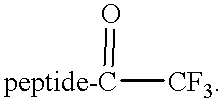Cysteine protease inhibitors containing heterocyclic leaving groups
a technology of cysteine protease and heterocyclic group, which is applied in the field of cysteine proteases, can solve the problems of reversible inhibition, mutagenicity, and use of diazoketones, and achieves the effect of reducing the number of cysteine proteases
- Summary
- Abstract
- Description
- Claims
- Application Information
AI Technical Summary
Problems solved by technology
Method used
Image
Examples
example 2
Synthesis of ##STR11##
In a 100 ml round bottom flask equipped with an argon line as placed Mu-Phe-HPhe-Br (300 mg, 0.581 mmol), potassium fluoride (134.8 mg, 2.33 mmol) potassium carbonate (321.4 mg, 2.33 mmol)-K.sub.2 CO.sub.3 was added to control the acidic environment, and 5,6-dihydro-4-hydroxy-6-methyl-2H-pyran-2-one (298.0 mg, 2.33 mmol). About 5 ml of DMF was added to dissolve the solid mixture. The reaction flask was immersed in a 50.degree. C. oil bath. The reaction was allowed to run for 40 minutes in order to ensure the completion of the reaction. The reaction mixture was diluted with ethyl acetate, and potassium fluoride was removed by a small silica gel column. The solvent ethyl acetate was removed by a water vacuum pump, and DMF was removed by an oil vacuum pump. The next day the light yellow product was recrystallized in 50:50 hexane:diethyl ether. The white precipitate was filtered and a NMR spectrum was obtained. m.p. 74-7.degree. C.
example 3
Synthesis of ##STR12##
In a 100 ml round bottom flask equipped with an argon line was placed Mu-Phe-HPhe-Br (1 g, 1.94 mmol), potassium fluoride (0.45 g, 7.75 mmol), potassium carbonate (1.07 g, 7.75 mmol)-K.sub.2 CO.sub.3 was added to control the acidic environment, and 2-hydroxy-3-methylcarboxypyridine (0.59 g, 3.87 mmol). About 5 ml of DMF was added to dissolve the solid mixture. The reaction flask was immersed in a 50.degree. C. oil bath. The reaction was allowed to run for 40 minutes in order to ensure the completion of the reaction. The reaction mixture was diluted with ethyl acetate, and potassium fluoride was removed by a small silica gel column. The solvent ethyl acetate was removed by a water vacuum pump, and DMF was removed by an oil vacuum pump. The next day the light yellow product was recrystallized in 50:50 hexane:diethyl ether. The white precipitate was filtered and a NMR spectrum was obtained. m.p. 100-102.degree. C.
example 4
Synthesis of ##STR13##
In a 100 ml round bottom flask equipped with an argon line was placed Mu-he-HPhe-Br (500 mg, 0.969 mmol), potassium fluoride (224.8 mg, 3.876 mmol), potassium carbonate (267.8mg, 1.938 mmol)-K.sub.2 CO.sub.3 was added to control the acidic environment, and 3-hydroxypyridine (184.3 mg, 1.938 mmol). About 5 ml of DMF was added to dissolve the solid mixture. The reaction flask was immersed in a 50.degree. C. oil bath. The reaction was allowed to run for 40 minutes in order to ensure the completion of the reaction. The reaction mixture was diluted with ethyl acetate, and potassium fluoride was removed by a small silica gel column. The solvent ethyl acetate was removed by a water vacuum pump, and DMF was removed by an oil vacuum pump. The next day the light yellow product was recrystallized in 50:50 hexane:diethyl ether. The white precipitate was filtered and a NMR spectrum was obtained. m.p. 112-115.degree. C.
PUM
| Property | Measurement | Unit |
|---|---|---|
| Volume | aaaaa | aaaaa |
| Volume | aaaaa | aaaaa |
| Volume | aaaaa | aaaaa |
Abstract
Description
Claims
Application Information
 Login to View More
Login to View More - R&D
- Intellectual Property
- Life Sciences
- Materials
- Tech Scout
- Unparalleled Data Quality
- Higher Quality Content
- 60% Fewer Hallucinations
Browse by: Latest US Patents, China's latest patents, Technical Efficacy Thesaurus, Application Domain, Technology Topic, Popular Technical Reports.
© 2025 PatSnap. All rights reserved.Legal|Privacy policy|Modern Slavery Act Transparency Statement|Sitemap|About US| Contact US: help@patsnap.com



